我們在看一組資料時常會以統計觀點來評斷,例如最大最小值、平均值、標準差等,以圖表則會用直方圖(histogram)來觀察資料的分布。今天就來練習畫histogram。
首先來做計算統計數據的function,分成兩部分一個是最大最小值、平均值、標準差,另一個是histogram的分bin。
在計算最大最小值、平均值、標準差時最麻煩的反而是最大最小值(如果不掛其他套件),因為原生Math.max和Math.min無法處理浮點數,所以我們就用loop寫個簡單土炮版本的,其餘平均值、標準差就用array的reduce照公式寫:
let totalNumber = data.length;
let dataMin = "";
let dataMax = "";
for (let i = 0; i < totalNumber; i++) {
let tempData = data[i];
if (dataMin) {
if (tempData < dataMin) {
dataMin = tempData;
}
}
else {
dataMin = tempData;
}
if (dataMax) {
if (tempData > dataMax) {
dataMax = tempData;
}
}
else {
dataMax = tempData;
}
}
let sum = data.reduce((preValue, curValue) => preValue + curValue);
let dataMean = sum / totalNumber;
let squrSum = data.reduce((preValue, curValue) => preValue + (curValue - dataMean)** 2);
let dataSTD = (squrSum / totalNumber) ** 0.5;
接下來是分bin的部分,我們做了兩種option,可以選擇切bin的總數,或是bin的寬度,再用if條件判斷換算完後,我們是從最小的值開始,往上加上bin寬度,然後計算區間內的數量為y值,區間範圍的中心點為x值,組成{x, y}的物件(這個長條圖也能吃喔),然後依序往上,而最後要注意的是再加bin的寬度時會有誤差,而在最高bin時要涵蓋最大值的那個計數,所以我們用if條件判斷特別處理最高的那個bin,是用小於等於資料的max值計數:
let botValue = dataMin;
let topValue;
if (Number.isInteger(binNumber)) {
binWidth = (dataMax - dataMin) / binNumber;
}
else if (!Number.isNaN(binWidth)) {
let dataSwing = dataMax - dataMin;
binNumber = Math.ceil(dataSwing / binWidth);
botValue = botValue + 0.5 * dataSwing - 0.5 * binWidth * binNumber;
}
let dataset = [];
for (let i = 0; i < binNumber; i++) {
topValue = botValue + binWidth;
let subList;
if (i === binNumber - 1) {
subList = data.filter(function(item) {
return (item >= botValue) & (item <= dataMax);
});
}
else {
subList = data.filter(function(item) {
return (item >= botValue) & (item < topValue);
});
}
dataset.push({x: (topValue + botValue) / 2, y: subList.length})
botValue = topValue
}
接下來是圖表的設定(可以參考裡面一系列的說明範例),我們初始化的設定如下面的code所示,部分是空的或是註解的是特別標記給上面的function計算後填入參數,另外其中比較重要的設定是options.scale.x.type設定linear、data.dataset的categoryPercentage和barPercentage和要設定為1,這樣長條圖間的縫隙才會連起來:
const data = {
datasets: [
{
label: 'DATA',
data: [],
borderColor: CHART_COLORS.blue,
backgroundColor: RGBwithA(CHART_COLORS.blue, 0.8),
borderWidth: 1,
barPercentage: 1,
categoryPercentage: 1,
},
]
};
const config = {
type: "bar",
data: data,
options: {
scales: {
x: {
type: 'linear',
offset: false,
grid: {
offset: false,
},
ticks: {
//stepSize: ,
},
//min:
//max:
},
y: {
},
},
plugins:{
legend:{
display: false,
},
}
},
};
最後我們用一個function可以random建data測試,然後將上方所寫的計算結果更新進chart中,其中設定options.scales.x.min、options.scales.x.max和options.scales.x.ticks.stepSize就能將格線與切bin對齊:
let histData = calculateHistogram(data, binWidth, binNumber);
chart.data.datasets.forEach(dataset => {
dataset.data = histData.dataset
});
chart.options.scales.x.min = histData.histMin;
chart.options.scales.x.max = histData.histMax;
chart.options.scales.x.ticks.stepSize = histData.binWidth;
chart.update();
成果如下,以一組200個點的常態分佈亂數資料:
用Number of bin=16:
用Number of bin=32:
用Bin width=2:
用Bin width=4:
